From time to time you may see here a message that NeverEndingBooks ends on Bloomsday (June 16th). Soon after, I hope to restart with another blog at the same URL. For starters, Neverendingbooks refers to my never-ending bookproject on noncommutative geometry started in 1999, a millenium ago… Today I\’m correcting the proofs and have even seen the cover-design of the book, supposed to be published in the fall. So, it should be really EndingBook(s), finally. From time to time it is good to start afresh. The next project is still pretty vague to me but it will be a lot more focussed and center around topics like Moonshine, the Monster, the Mathieu groups, Modular forms and group etc. Suggestions for a blogtitle are welcome (M-theory is already taken…). Besides there are technical problems with the machine running the blog, a new one is expected around June 16th. As I will not be able to clone between the two (one PPC, the new one Intel) I decided to start again from scratch. Anyway, Ive made a database-dump of NeverEndingBooks and will make it available to anyone interested in reading old posts (even the ones with a private-status). Finally, there are other reasons, better kept private. Give me a couple of weeks to resurface. For now, all the best.
Leave a CommentTag: noncommutative
After a lengthy spring-break, let us continue with our course on noncommutative geometry and $SL_2(\mathbb{Z}) $-representations. Last time, we have explained Grothendiecks mantra that all algebraic curves defined over number fields are contained in the profinite compactification
$\widehat{SL_2(\mathbb{Z})} = \underset{\leftarrow}{lim}~SL_2(\mathbb{Z})/N $ of the modular group $SL_2(\mathbb{Z}) $ and in the knowledge of a certain subgroup G of its group of outer automorphisms. In particular we have seen that many curves defined over the algebraic numbers $\overline{\mathbb{Q}} $ correspond to permutation representations of $SL_2(\mathbb{Z}) $. The profinite compactification $\widehat{SL_2}=\widehat{SL_2(\mathbb{Z})} $ is a continuous group, so it makes sense to consider its continuous n-dimensional representations $\mathbf{rep}_n^c~\widehat{SL_2} $ Such representations are known to have a finite image in $GL_n(\mathbb{C}) $ and therefore we get an embedding $\mathbf{rep}_n^c~\widehat{SL_2} \hookrightarrow \mathbf{rep}_n^{ss}~SL_n(\mathbb{C}) $ into all n-dimensional (semi-simple) representations of $SL_2(\mathbb{Z}) $. We consider such semi-simple points as classical objects as they are determined by – curves defined over $\overline{Q} $ – representations of (sporadic) finite groups – modlart data of fusion rings in RCTF – etc… To get a feel for the distinction between these continuous representations of the cofinite completion and all representations, consider the case of $\hat{\mathbb{Z}} = \underset{\leftarrow}{lim}~\mathbb{Z}/n \mathbb{Z} $. Its one-dimensional continuous representations are determined by roots of unity, whereas all one-dimensional (necessarily simple) representations of $\mathbb{Z}=C_{\infty} $ are determined by all elements of $\mathbb{C} $. Hence, the image of $\mathbf{rep}_1^c~\hat{\mathbb{Z}} \hookrightarrow \mathbf{rep}_1~C_{\infty} $ is contained in the unit circle
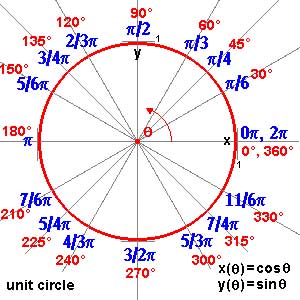
and though these points are very special there are enough of them (technically, they form a Zariski dense subset of all representations). Our aim will be twofold : (1) when viewing a classical object as a representation of $SL_2(\mathbb{Z}) $ we can define its modular content (which will be the noncommutative tangent space in this classical point to the noncommutative manifold of $SL_2(\mathbb{Z}) $). In this way we will associate noncommutative gadgets to our classical object (such as orders in central simple algebras, infinite dimensional Lie algebras, noncommutative potentials etc. etc.) which give us new tools to study these objects. (2) conversely, as we control the tangentspaces in these special points, they will allow us to determine other $SL_2(\mathbb{Z}) $-representations and as we vary over all classical objects, we hope to get ALL finite dimensional modular representations. I agree this may all sound rather vague, so let me give one example we will work out in full detail later on. Remember that one can reconstruct the sporadic simple Mathieu group $M_{24} $ from the dessin d’enfant
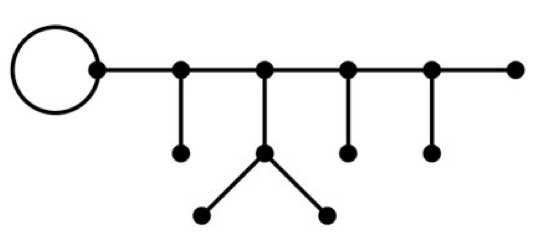
- This
- dessin determines a 24-dimensional permutation representation (of
- $M_{24} $ as well of $SL_2(\mathbb{Z}) $) which
- decomposes as the direct sum of the trivial representation and a simple
- 23-dimensional representation. We will see that the noncommutative
- tangent space in a semi-simple representation of
- $SL_2(\mathbb{Z}) $ is determined by a quiver (that is, an
- oriented graph) on as many vertices as there are non-isomorphic simple
- components. In this special case we get the quiver on two points
- $\xymatrix{\vtx{} \ar@/^2ex/[rr] & & \vtx{} \ar@/^2ex/[ll]
- \ar@{=>}@(ur,dr)^{96} } $ with just one arrow in each direction
- between the vertices and 96 loops in the second vertex. To the
- experienced tangent space-reader this picture (and in particular that
- there is a unique cycle between the two vertices) tells the remarkable
- fact that there is **a distinguished one-parameter family of
- 24-dimensional simple modular representations degenerating to the
- permutation representation of the largest Mathieu-group**. Phrased
- differently, there is a specific noncommutative modular Riemann surface
- associated to $M_{24} $, which is a new object (at least as far
- as I’m aware) associated to this most remarkable of sporadic groups.
- Conversely, from the matrix-representation of the 24-dimensional
- permutation representation of $M_{24} $ we obtain representants
- of all of this one-parameter family of simple
- $SL_2(\mathbb{Z}) $-representations to which we can then perform
- noncommutative flow-tricks to get a Zariski dense set of all
- 24-dimensional simples lying in the same component. (Btw. there are
- also such noncommutative Riemann surfaces associated to the other
- sporadic Mathieu groups, though not to the other sporadics…) So this
- is what we will be doing in the upcoming posts (10) : explain what a
- noncommutative tangent space is and what it has to do with quivers (11)
- what is the noncommutative manifold of $SL_2(\mathbb{Z}) $? and what is its connection with the Kontsevich-Soibelman coalgebra? (12)
- is there a noncommutative compactification of $SL_2(\mathbb{Z}) $? (and other arithmetical groups) (13) : how does one calculate the noncommutative curves associated to the Mathieu groups? (14) : whatever comes next… (if anything).
In another post we introduced
Minkowski’s question-mark function, aka the devil’s straircase
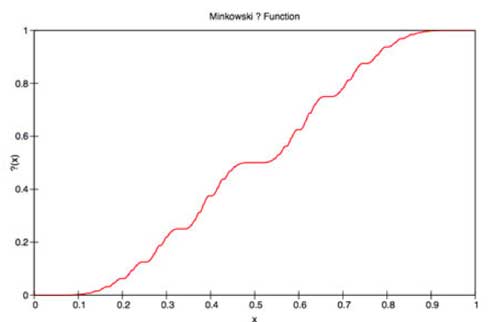 and related it to
and related it to
Conways game of _contorted fractions_. Side remark : over at Good Math, Bad Math Mark Chu-Carroll is running
a mini-series on numbers&games, so far there is a post on surreal numbers,
surreal arithmetic and the connection with
games but
probably this series will go on for some time.
About a year ago I had
an email-exchange with Linas Vepstas because I was
intrigued by one of his online publications linking the fractal
symmetries of the devil’s staircase to the modular group. Unfortunately,
his paper contained some inaccuracies and I’m happy some of my comments
made it into his rewrite The Minkowski question mark, GL(2,Z) and the
modular group. Still, several
mistakes remain so read this paper only modulo his own caveat
XXXX This paper is unfinished. Although this version
corrects a number of serious errors in the previous drafts, it is still
misleading and confusing in many ways. The second half, in particular
must surely contain errors and mis-statements! Caveat emptor! XXXX
For example, on page 15 of the march 24-version he claims
that the third braid group $B_3 \simeq SL_2(\mathbb{Z}) $ which
would make life, mathematics and even physics a lot easier, but
unfortunately is not true. Recall that Artin’s defining relation for the
3-string braid group is $\sigma_1 \sigma_2 \sigma_1 = \sigma_2
\sigma_1 \sigma_2 $ as can be seen because the 3-strings below can
be transformed into each other
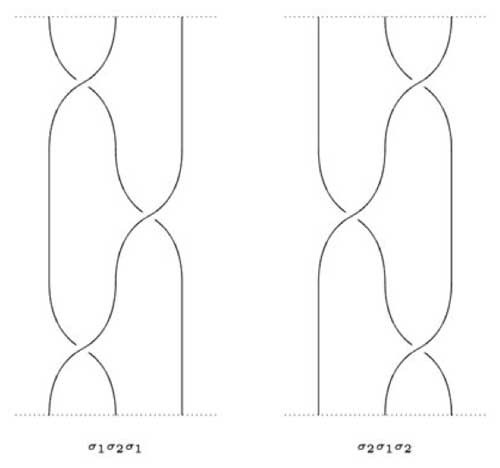 But from this
But from this
relation it follows that $c=(\sigma_1 \sigma_2 \sigma_1)^2 $ is
a central element in $B_3 $ and it is not difficult to verify
that indeed $B_3/ \langle c \rangle \simeq PSL_2(\mathbb{Z}) $
and $B_3/ \langle c^2 \rangle \simeq SL_2(\mathbb{Z}) $ An easy
way to see that the third braid group and the modular group are quite
different is to look at their one-dimensional representations. Any
group-map $B_3 \rightarrow \mathbb{C}^_ $ is determined by
non-zero complex numbers x and y satisfying $x^2y=y^2x $ so are
parametrized by the torus $\mathbb{C}^_ $ whereas there are only
6 one-dimensional representations of $PSL_2(\mathbb{Z}) = C_2 \ast
C_3 $ (and similarly, there are only 12 one-dimensional
$SL_2(\mathbb{Z}) $-representations). Btw. for those still
interested in noncommutative geometry : $(P)SL_2(\mathbb{Z}) $
are noncommutative manifolds whereas $B_3 $ is definitely
singular, if I ever get to the definitions of all of this… Still,
there is a gem contained in Linas’ paper and here’s my reading of it :
the fractal symmetries of the devil’s staircase form a generating
sub-semigroup $C_2 \ast \mathbb{N} $ of
$GL_2(\mathbb{Z}) $ . To begin, let us recall that the
question-mark function is defined in terms of continued fraction
expressions. So, what group of symmetries may be around the corner?
Well, if $a = \langle a_0;a_1,a_2,\ldots \rangle $ is the
continued fraction of a (see this
post for details) then if we
look at the n-th approximations $\frac{p_n}{q_n} $ (that is, the
rational numbers obtained after breaking off the continued fraction at
step n) it is failrly easy to show that $\begin{bmatrix} p_n &
p_{n-1} \\ q_n & q_{n-1} \end{bmatrix} \in GL_2(\mathbb{Z}) $ and
recall (again) that this group acts on
$\mathbb{P}^1_{\mathbb{C}} $ via Moebius transformations
$\begin{bmatrix} a & b \ c & d \end{bmatrix} $ via $z
\mapsto \frac{az+b}{cz+d} $ One of the symmetries is easy to spot
(reflexion along the 1/2-axis) 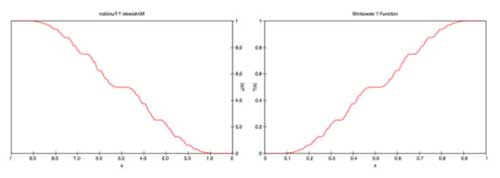 That is, $?(x-1) = 1 – ?(x) $ Observe that the left-hand
That is, $?(x-1) = 1 – ?(x) $ Observe that the left-hand
side transformation is given by the Moebius transformation determined by
the matrix $r = \begin{bmatrix} -1 & 1 \\ 0 & 1 \end{bmatrix} \in
GL_2(\mathbb{Z}) $ Other symmetries are harder to see as they are
_fractal symmetries_, that is they are self-symmetries but at different
scales. For example, let us blow-up the ?-function at the interval
[1/3,1/2] and compare it with the function at the interval [1/2,1] 
which has the same graph, while halving the function value. More
generally, substituting the ?-function definition using continued
fraction expressions one verifies that $?(\frac{x}{x+1}) =
\frac{1}{2} ?(x) $ and this time the left-hand transformation is
determined by the matrix $g = \begin{bmatrix} 1 & 0 \\ 1 & 1
\end{bmatrix} \in GL_2(\mathbb{Z}) $ We obtain a semi-group $S
= \langle r,g \rangle $ of fractal symmetries which are induced (the
right hand sides of the above expressions) via a 2-dimensional
representation of S $S \rightarrow GL_2(\mathbb{C})~\qquad r
\mapsto \begin{bmatrix} 1 & 0 \\ 1 & -1 \end{bmatrix}~\qquad g \mapsto
\begin{bmatrix} 1 & 0 \\ 0 & \frac{1}{2} \end{bmatrix} $ acting
via left-multiplication on the two-dimensional vectorspace
$\mathbb{C}1+\mathbb{C}x $. We claim that S is the free
semi-group $C_2 \ast \mathbb{N} $. Clearly, $r^2=1 $ and
g is of infinite order, but we have to show that no expression of the
form $rg^{i_1}rg^{i_2}r \ldots rg^{i_l}r $ can be the identity
in S. We will prove this by computing its action on the continued
fraction expression of $a = \langle 0;a_0,a_1,\ldots \rangle $.
It is a pleasant exercise to show that $g. \langle 0;a_1,a_2,\ldots
\rangle = \langle 0;a_1+1,a_2,\ldots \rangle $ whence by induction
$g^n. \langle 0;a_1,a_2,\ldots \rangle = \langle 0;a_1+n,a_2,\ldots
\rangle $ Moreover, the action on r is given by $r. \langle
0;a_1,a_2,\ldots \rangle = \langle 0;1,a_1-1,a_2,\ldots \rangle $ if
$a_1 \not= 1 $ whereas $r. \langle 0;1,a_2,a_3,\ldots
\rangle = \langle 0;a_2+1,a_3,\ldots \rangle $ But then, as a
consequence we have that $g^{n-1}rg . \langle 0;a_1,a_2,\ldots
\rangle = \langle 0;n,a_1,a_2,\ldots \rangle $ and iterating this
procedure gives us finally that an expression $g^{j-1} r g^k r g^l
r \ldots g^z r g = (g^{j-1} r g)(g^{k-1} r g)(g^{l-1} r g) \ldots
(g^{z-1} r g) $ acts on $a = \langle 0;a_1,a_2,\ldots
\rangle $ by sending it to $\langle
0;j,k,l,\ldots,z,a_1,a_2,\ldots \rangle $ whence such an expression
can never act as the identity element, proving that indeed $S \simeq
C_2 \ast \mathbb{N} $. As for the second claim, recall from this
post that
$GL_2(\mathbb{Z}) $ is generated by the matrices $U =
\begin{bmatrix} 0 & -1 \ 1 & 0 \end{bmatrix}~\quad V = \begin{bmatrix}
0 & 1 \ -1 & 1 \end{bmatrix}~\quad R = \begin{bmatrix} 0 & 1 \ 1 & 0
\end{bmatrix} $ and a straightforward verification shows that
$r = RV,~\quad g = VU $ and $R = g^{-1}rg,~\quad
V=g^{-1}rgr,\quad U=rg^{-1}rg^2 $ whence, indeed, the semi-group S
generates the whole of $GL_2(\mathbb{Z}) $!